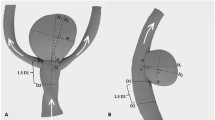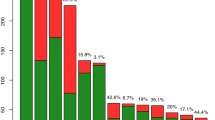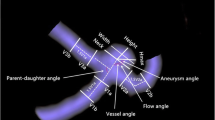Abstract
Introduction
Geometric indices of cerebral aneurysms have been widely studied to determine rupture risk. However, most of these parameters were evaluated based on two-dimensional (2D) images and could have a measurement bias. We propose a new three-dimensional geometric index, an aneurysm volume-to-neck area ratio (VNR). To determine whether the VNR of ruptured aneurysms is different from that of unruptured aneurysms, we compared VNR with other 2D geometric indices in discriminative capacity for aneurysm rupture status.
Methods
Two hundred fourteen aneurysms in 195 patients (mean age, 57.44 ± 11.21 years; males, 69; females, 126) were retrospectively evaluated. There were 105 ruptured and 109 unruptured aneurysms. The five geometric indices [aspect ratio (AR), bottleneck ratio (BR), height-width ratio (HWR), volume, and VNR] were calculated from angiographic data and assessed to determine correlation with aneurysm rupture (t test). Receiver operating characteristic (ROC) curve analysis was used for comparison of discriminative capacity between different indices.
Results
AR, BR, HWR, and VNR were correlated with rupture status. Areas under the ROC curve of the aspect ratio and VNR were significantly larger than that of the HWR, BR, and volume. However, AR and VNR did not show a significant difference.
Conclusion
A larger aneurysm volume in proportion to the neck could be one of the geometric indices of aneurysms that indicate a higher rupture risk. This characteristic is represented by the aspect ratio.



Similar content being viewed by others
References
Raghavan ML, Ma B, Harbaugh RE (2005) Quantified aneurysm shape and rupture risk. J Neurosurg 102:355–362
Ujiie H, Tamano Y, Sasaki K, Hori T (2001) Is the aspect ratio a reliable index for predicting the rupture of a saccular aneurysm? Neurosurgery 48:495–502
Nader-Sepahi A, Casimiro M, Sen J, Kitchen ND (2004) Is aspect ratio a reliable predictor of intracranial aneurysm rupture? Neurosurgery 54:1343–1347
Hoh BL, Sistrom CL, Firment CS, Fautheree GL, Velat GJ, Whiting JH, Reavey-Cantwell JF, Lewis SB (2007) Bottleneck factor and height–width ratio: association with ruptured aneurysms in patients with multiple cerebral aneurysms. Neurosurgery 61:716–722
Dhar S, Tremmel M, Mocco J, Kim M, Yamamoto J, Siddiqui AH, Hopkins LN, Meng H (2008) Morphology parameters for intracranial aneurysm rupture risk assessment. Neurosurgery 63:185–196. doi:10.1227/01.NEU.0000316847.64140.81
Sadatomo T, Yuki K, Migita K, Taniguchi E, Kodama Y, Kurisu K (2008) Morphological differences between ruptured and unruptured cases in middle cerebral artery aneurysms. Neurosurgery 62:602–609. doi:10.1227/01.NEU.0000311347.35583.0C
Ujiie H, Tachibana H, Hiramatsu O, Hazel AL, Matsumoto T, Ogasawara Y, Nakajima H, Hori T, Takakura K, Kajiya F (1999) Effects of size and shape (aspect ratio) on the hemodynamics of saccular aneurysms: a possible index for surgical treatment of intracranial aneurysms. Neurosurgery 45:119–129
Piotin M, Daghman B, Mounayer C, Spelle L, Moret J (2006) Ellipsoid approximation versus 3d rotational angiography in the volumetric assessment of intracranial aneurysms. AJNR Am J Neuroradiol 27:839–842
Parlea L, Fahrig R, Holdsworth DW, Lownie SP (1999) An analysis of the geometry of saccular intracranial aneurysms. AJNR Am J Neuroradiol 20:1079–1089
Yamura M, Hirai T, Korogi Y, Ikushima I, Yamashita Y (2005) Quantitative evaluation of measurement accuracy for three-dimensional angiography system using various phantoms. Radiat Med 23:175–181
Byun HS, Rhee K (2003) Intraaneurysmal flow changes affected by clip location and occlusion magnitude in a lateral aneurysm model. Med Eng Phys 25:581–589
Fluss R, Faraggi D, Reiser B (2005) Estimation of the Youden Index and its associated cutoff point. Biom J 47:458–472
Ozdamar N, Celebi G (1978) Pressure distribution on the wall of experimental aneurysms. Acta Neurochir 45:27–34
Kerber CW, Heilman CB (1983) Flow in experimental berry aneurysms: method and model. AJNR Am J Neuroradiol 4:374–377
Tateshima S, Chien A, Sayre J, Cebral J, Vinuela F (2010) The effect of aneurysm geometry on the intra-aneurysmal flow condition. Neuroradiology. doi:10.1007/s00234-010-0687-4
Beck J, Rohde S, El Beltagy M, Zimmermann M, Berkefeld J, Seifert V, Raabe A (2003) Difference in configuration of ruptured and unruptured intracranial aneurysms determined by biplanar digital subtraction angiography. Acta Neurochir 145:861–865. doi:10.1007/s00701-003-0124-0
Weir B, Amidei C, Kongable G, Findlay JM, Kassell NF, Kelly J, Dai L, Karrison TG (2003) The aspect ratio (dome/neck) of ruptured and unruptured aneurysms. J Neurosurg 99:447–451
Ma B, Harbaugh RE, Raghavan ML (2004) Three-dimensional geometrical characterization of cerebral aneurysms. Ann Biomed Eng 32:264–273
Acknowledgment
This work was supported by the program of Kyung Hee University for the Young Researcher in Medical Science (KHU-2010719).
Conflict of interest statement
We declare that we have no conflict of interest.
Author information
Authors and Affiliations
Corresponding author
Rights and permissions
About this article
Cite this article
Ryu, CW., Kwon, OK., Koh, J.S. et al. Analysis of aneurysm rupture in relation to the geometric indices: aspect ratio, volume, and volume-to-neck ratio. Neuroradiology 53, 883–889 (2011). https://doi.org/10.1007/s00234-010-0804-4
Received:
Accepted:
Published:
Issue Date:
DOI: https://doi.org/10.1007/s00234-010-0804-4




